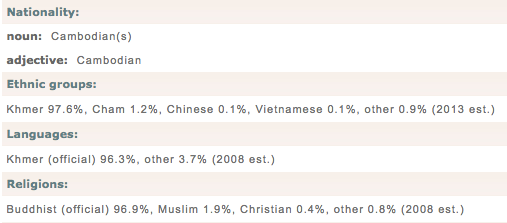GLOBAL HEALTH PERSPECTIVES

The Kingdom of Cambodia is located in Southeastern Asia where it is bordered by Thailand, Laos, and Vietnam. The country totals 181,035 square kilometers, making it smaller than the state of Oklahoma and 1.5 times the size of Pennsylvania. The total population is 15,762,370 (The World Bank Group, 2017). Most of Cambodia’s population is concentrated in the southeast near the capital of Phnom Penh, and near the Tonle Sap, Southeast Asia’s largest freshwater lake, and Mekong River (Central Intelligence Agency [CIA], 2018). Demographically, the largest ethnic group is Khmer, the main religion is Buddhism, and the official language is Khmer; the median age is 25.3 years and the population growth rate is currently 1.52 percent (CIA, 2018).
Overview: Beyond Cambodia
Source: GoPro. (2017, October 23). GoPro travel: Beyond Cambodia [Video file]. Retrieved from https://www.youtube.com/watch?time_continue=136&v=hj9Vh2NagqA

INTRODUCTION
Cambodia

(Source: CIA, 2018)
Climate & Natural Resources: Most of Cambodia’s terrain is comprised of low, flat plains with mountains in the southwest and north parts of the country. The climate is tropical and generally hot and humid with an average temperature of 80 ° F (27 ° C). A rainy, monsoon season occurs from May to November, and a dry season from December to April. Natural resources include oil, gas, iron ore, timber, gemstones, manganese, phosphates, arable land, and hydropower potential. However, most of Cambodia’s economy relies on tourism, garment-making, agriculture, fisheries, and exportation of rubber (CIA, 2018; Cambodian Information Center [CIC], 2018).

Historical Perspective & Political Climate: The Angkor Empire ruled much of Southeast Asia between the 10th and 13th centuries, and a large number of the Cambodian population today identify themselves as Khmers, or descendants of the Angkor Empire. The Empire eventually declined after enduring attacks from what is now present-day Vietnam; therefore, it became part of French Indochina in 1887 after utilizing French protection in 1863. It wasn’t until after World War II, in 1953, that Cambodia gained independence from France. Political unrest continued for many years until 1975 when the Khmer Rouge, a communist regime, took hold of the capital; an estimated 1.5 million Cambodians died as a result of starvation, execution, and labor camps during the rule of the Khmer Rouge (CIA, 2018). In 1978, Vietnamese forces overpowered the regime and occupied the country until 1989. After the Paris Peace Agreements of 1991, conflict and civil war continued to plague the country. In 1993, the United Nations helped to establish a coalition government by holding elections; unfortunately, political stability did not last and a second coalition government was elected in 1998. Currently, Cambodia’s government is a constitutional monarchy and parliamentary representative democracy. The head of state is King Norodom Sihamoni, and the head of government is Prime Minister Hun Sen (CIC, 2018).
(Source: GoAsiaTravel.com)
